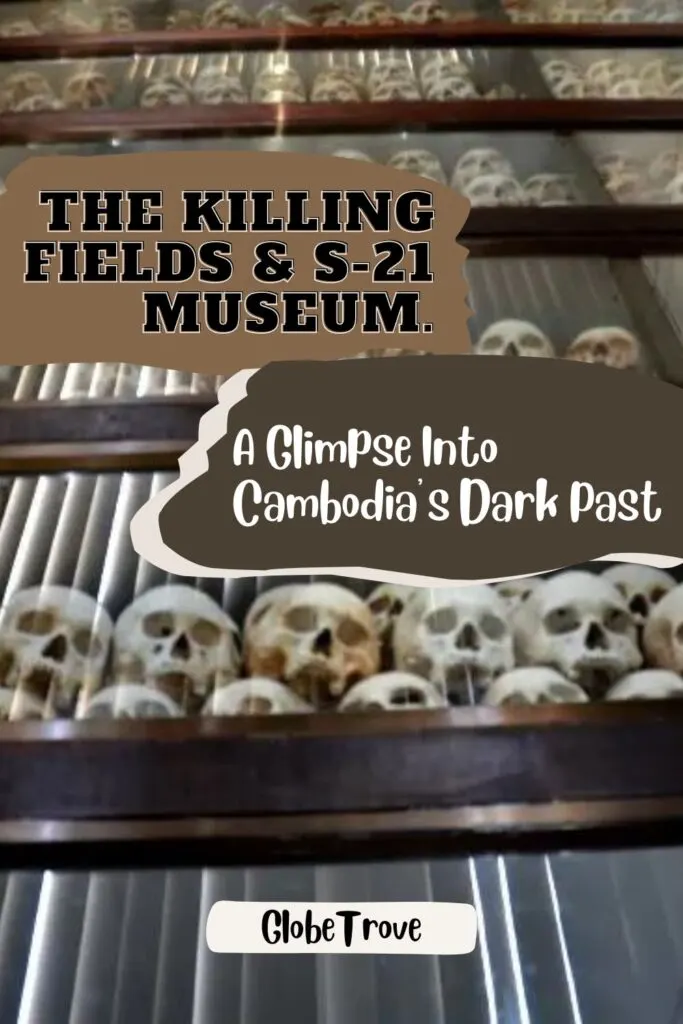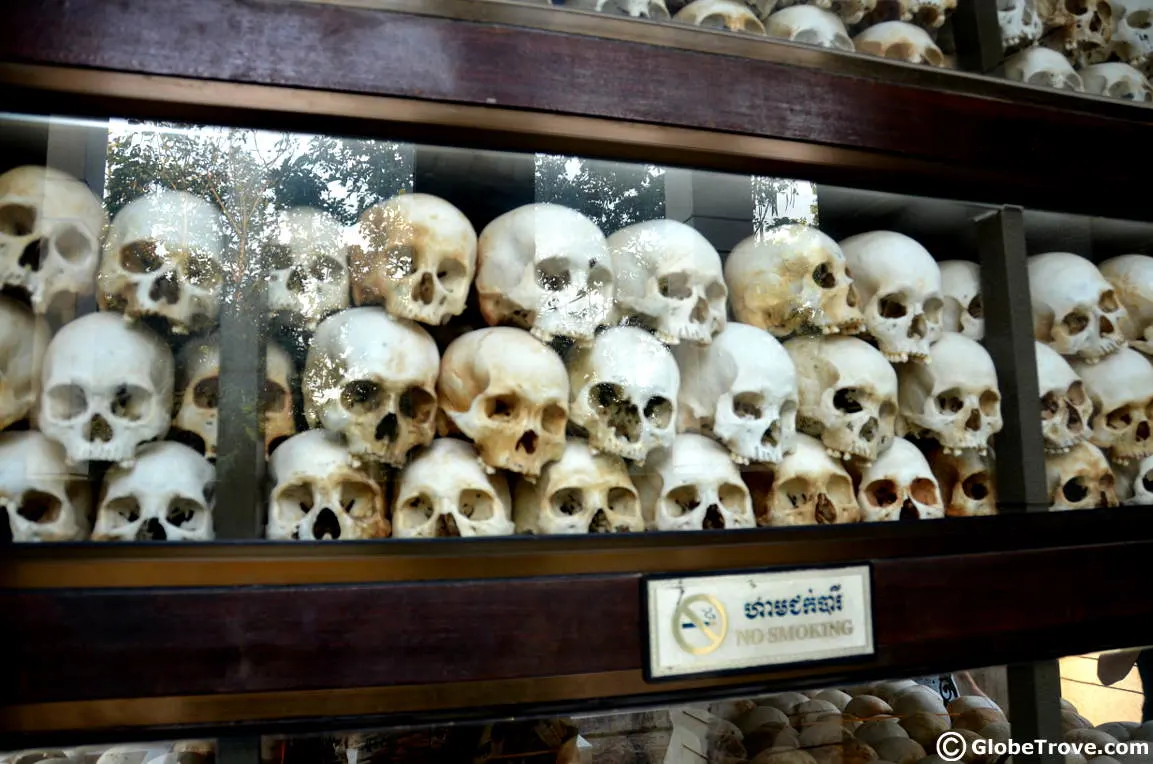A distance away from Cambodia’s Phnom Penh lies a vast expanse of land that we today refer as the Killing field. It is a remnant of the past but it tells of horrors so that the future generations will never ever forget.
I don’t know about you but we hardly knew anything about the Khmer Rouge before we entered Vietnam and Cambodia. I knew that both the countries had been through wars but that was the extent to which my general knowledge took me. Which is sad in a way but like I always say… Travel is the greatest teacher.
I’m not going to go into the details of how the Khmer rouge committed genocide during their rule. In this post I’m going to focus on what we saw and what we heard. Let me take you for a walk through the killing fields of Cambodia.
Since the killing fields were at a distance away from where we stayed, we decided to use a tour. The tour included a stop at the S-21 (I will explain shortly) museum and a tour of the killing fields themselves.
This post may contain affiliate links. As an Amazon Associate, I earn a small commission from qualifying purchases at no additional cost to you. Read my disclaimer for further information.
Book this Killing Fields And S-21 Museum Tour now! It is one of the top rated tours in the city! 😃
FIRST STOP: S-21 Museum
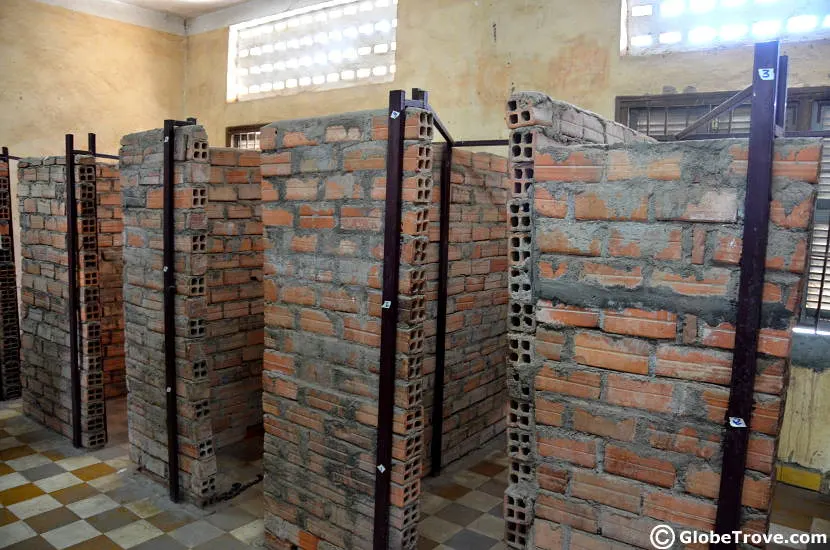
The cells of the poor inmates in the S-21 museum.
Our journey to the killing fields was kicked off with a visit to what is known as the S-21 Museum. S-21 stands for Security Prison 21. This was a prison that was used by the Khmer Rouge to detain and torture the Cambodians who were accused of varied crimes.
The sad part about this entire complex of buildings is the fact that The S-21 museum was originally a school. As you walk through the buildings you can see how the class rooms were converted to house the prisoners.
Each floor of each building is designed differently. Some rooms have smaller cubicles that are separated by wood. Others have cubicles that are made of stone.
The balconies of these buildings are long and are lined with barbed wire mesh. It is said that this barbed wire is in place so that none of the prisoners could end their lives on their own terms.
There is a lot of information that is displayed in these halls but none is quite as unsettling as the rows and rows of photographs of the prisoners who were executed. It is said that the Khmer Rouge kept both before and after photographs of their victims.
Something that struck as even more saddening is the fact that there are so many people (approximately one third of the population) who died or went missing in just 3 years of the Khmer Rouge rule.
Most of the families have no idea where their missing relatives are. They don’t know if they are alive or they are dead.
The only way that they can try and locate them is by going through each and every one of those photographs that are displayed at the S-21 museum hoping against hope that they will find them. Then again it leads one to wonder whether finding their relatives face is really a good thing?
The Journey To The Killing Fields
The journey to the killing fields was long enough for us to watch a documentary on the rise and fall of the Khmer Rouge leader Pol Pot. While it may have been boring to some, I found it a good introduction to what we were to see a little later in the day.
The Cost Of The Tour
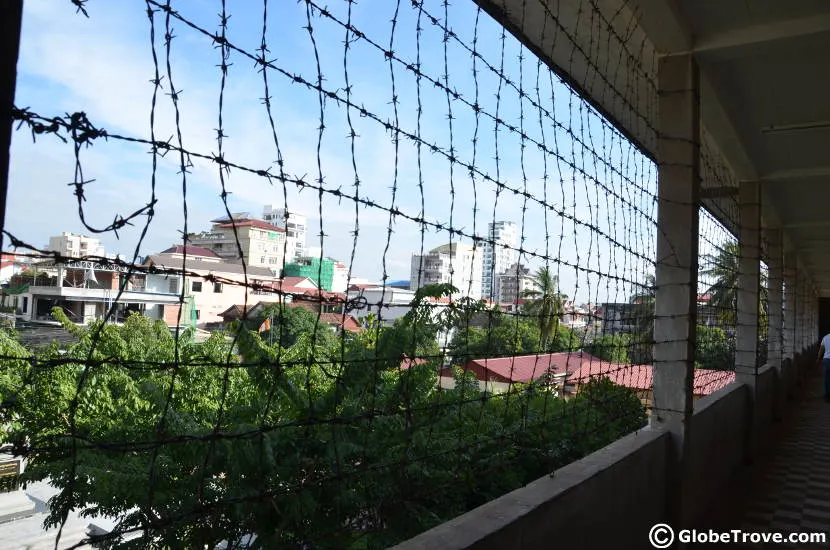
A view that the inmates of the S-21 prison had. The barbed wire kept them from committing suicide.
The cost of the tour to the killing fields and the genocide museum normally does not include the entrance fees. This is something that you must keep in mind because many tourists are often caught off guard. While they call it a tour the cost covers transport, a bottle of water and a guide who speaks English.
So how much did we pay?
The actual cost of the tour is $20 per person but the company that we booked at gave it to us for $15 per person since we were booking for two people. The cost of entrance fees at both the museum and the killing fields is $3 while the cost of the audio guide is also $3.
Do you need the audio guide?
We at first did not take an audio guide through the S-21 Genocide museum. It was there that we learned that a lot of the information is not provided on the walls. Even so the S-21 Genocide museum still has plenty to read.
The killing fields on the other hand are a different story. While there are intermittently placed signs, we found our audio guides useful and highly informative.
Is it worth taking the tour?
I’m honestly not really sure. Why did we take the tour? Now that is a question that I can answer. There were two options which we could use to reach the killing fields other than a tour. One was a tuk tuk and the second was renting a bike.
The climate in Cambodia is hot and dry which makes riding a bike tiring. I’m from India and I say that so you guess my baseline. A tuk tuk was better option but the roads are dusty, the tuk tuk would be less comfortable and the cost would have been similar to taking the so called tour. So we settled on the tour.
The Killing Fields Of Cambodia
You enter the killing fields only to realize one thing. You expect gruesome horrors but you are actually greeted by plenty of green, a well kept landscape, a couple of butterflies and plenty of birds breaking the silence with their voices.
It is surreal that this quiet calm landscape masks the horrors that happened just a few years ago.
The Memorial Stupa
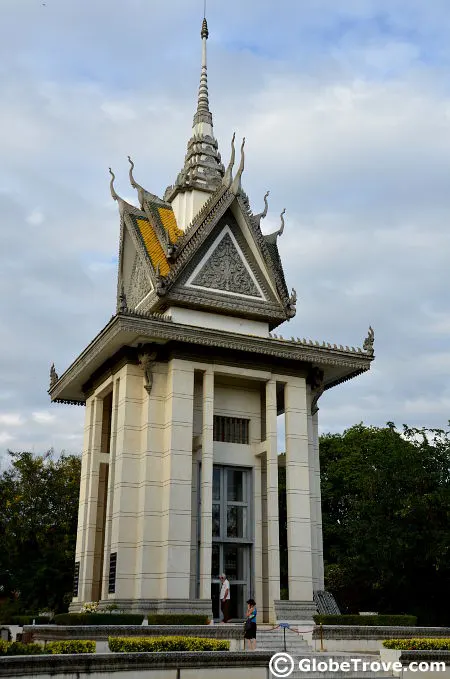
Some memories are too hard to process.
A tall structure at the entrance is a memorial of sorts to the men, women and children who lost their lives during the rule of the Khmer Rouge. The audio guide explains in depth how different symbols are used in the structure’s construction to depict peace.
The inside of the memorial houses the bones and skulls of the victims of the Khmer Rouge. In fact you can see exactly how each person was put to death.
The Story That Mere Scraps Of Cloth Can Tell At The Killing Fields
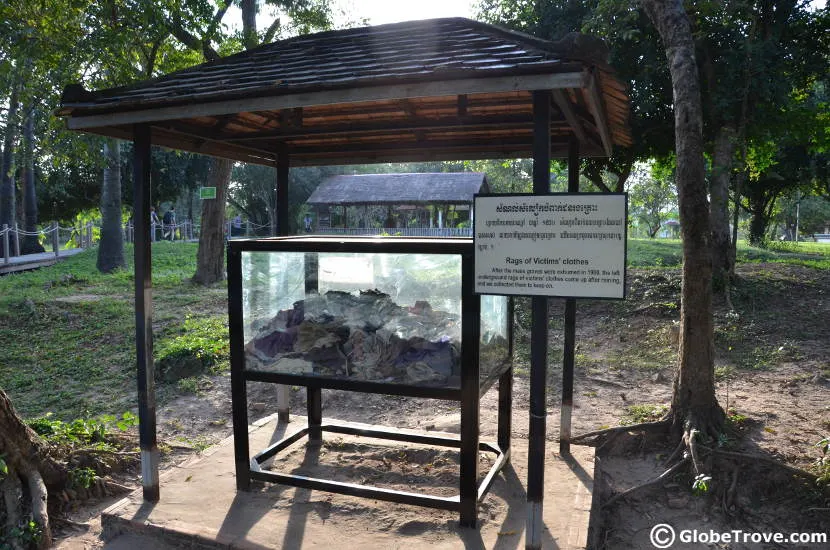
Even scraps of cloth tell a tale at the Killing Fields.
A small glass tank houses the remains of many items of clothing. Look closely and you will see that the clothes belonged to men, women and even children.
A few long scraps look as if they were used as blindfolds. The audio guide tells us that every year after the rains more scraps of clothes are found along with bones. I was saddening and at some point we began to feel as if the dead were so tormented that they couldn’t rest.
There Is Just Too Much To Tell
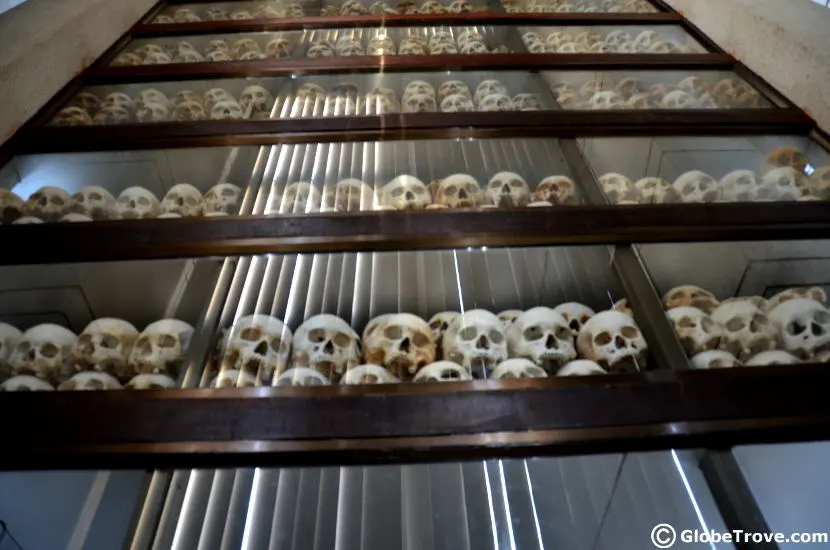
Head stacked upon head tells the story of agony of so many.
Yes! There is just too much to tell about the killing fields. The tree against which baby’s heads were smashed and the way men and women were killed are just the tip of the iceberg. Bullets were too expensive to use and hence any and every article that could be used to kill a person was picked up.
The experience was overwhelming. It was nauseating! I cannot believe that something of this magnitude happened in 70’s.
Then I have to remind myself of the wars that are currently on at the moment. The horrors that people face in places like Aleppo… The clock will turn and after a few decades we will look back again and say “Oh! That should never have happened and will never happen again!”
We will say this while it is still happening in another country in another part of the globe.
Yes the killing fields are sickening, disheartening and inhuman but go anyway. It will remind you that bad men lurk not in the shadows but in plain sight.
Go because you need to see firsthand what sorrow looks like. Go because you must learn that history does repeat.
A lot of us are so much luckier than others. Traveling teaches you how similar we are. How human we are. Many people shy away from places like the Genocide museum or the killing fields stating that they are horrors they don’t want to see.
Maybe you don’t want to but it changes you. It makes you more open to understanding what people who are in war zones undergo.
